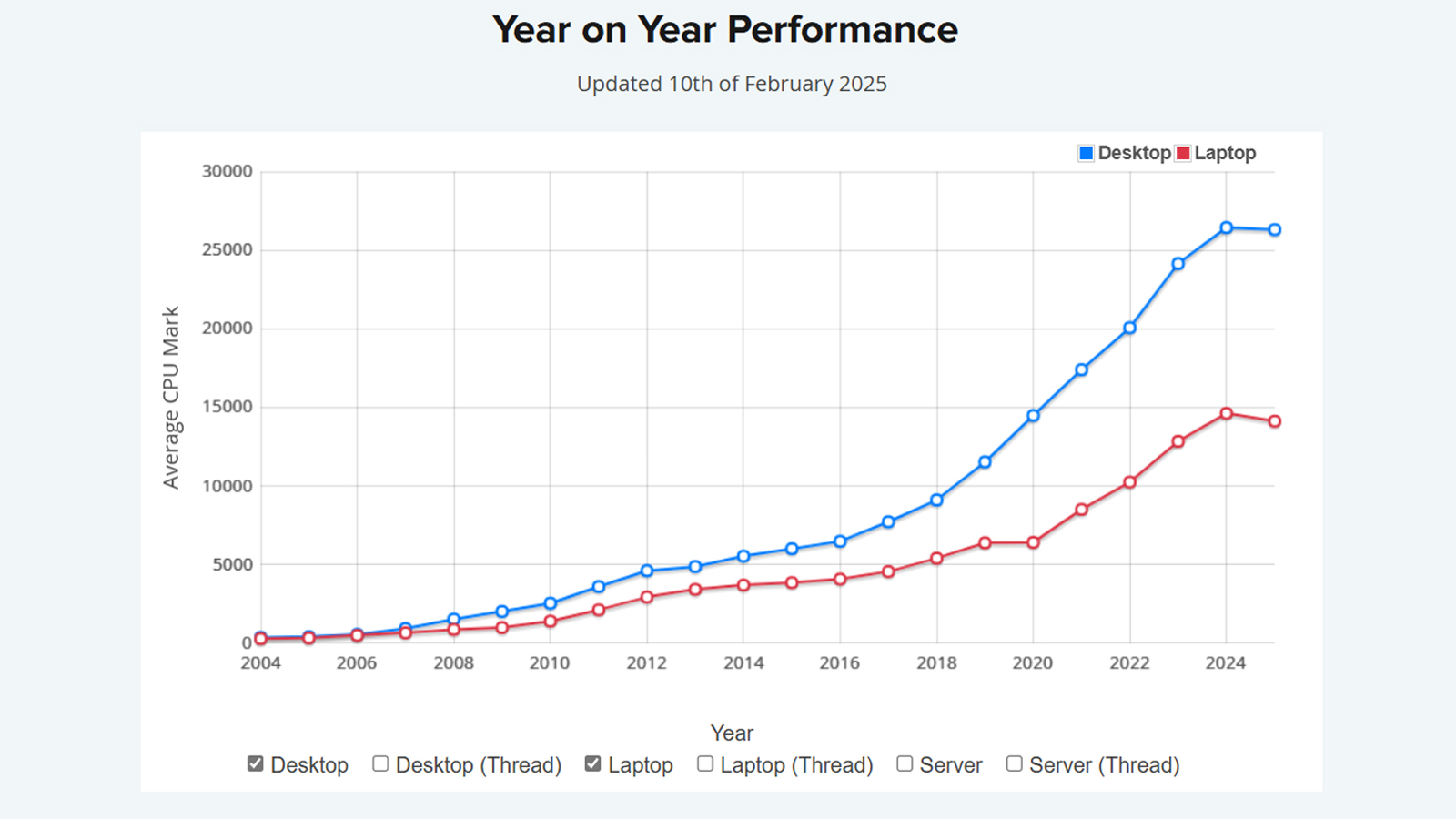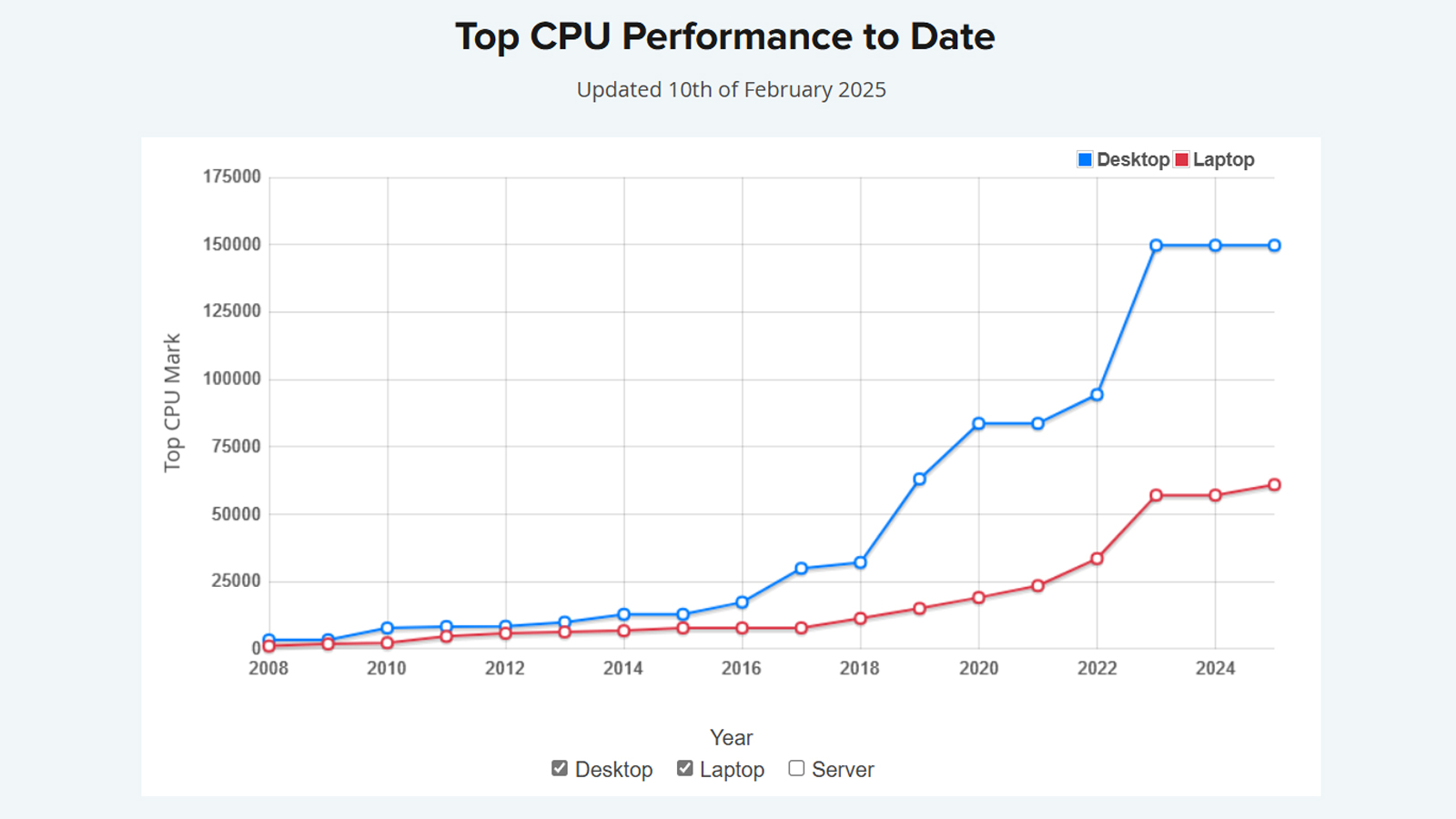PassMark sees the first yearly drop in average CPU performance in its 20 years of benchmark results
After the MHz and multi-core wars, performance drops.

Benchmarking software developer PassMark publishes the average results of all Windows PC tests across the globe every two weeks in a line graph. In line with what many enthusiasts might expect, the PassMark graph has always shown a consistent increase in processor performance year-on-year. However, for the first time since the company started keeping track in 2004, the average CPU mark score for desktop and laptop processors has dropped, with laptops dropping 3.4% year-over-year.
We see the biggest drop in laptop CPU performance results. PassMark recorded an average result of 14,632 across 101,316 samples last year. But, in 2025, the average score sat at an average of 14,130 points between 25,541 samples, decreasing the average score by 3.4%.
The average desktop PC result in 2024 netted 26,436 points for 186,053 samples. But for 2025, the average score currently sits at 26,311 points for over 47,810 samples — a 0.5% drop from last year. While that drop is small, we should only see a continued progression of faster performance.


We’ve also seen results for the top-performing CPUs, and it seems that we’ve basically reached a performance plateau, will little to no uplift in PassMark scores for the past three years for desktop chips and laptop CPUs. This happened after we received a massive uplift of 58.6% in the Top Desktop CPU benchmark scores in 2023, with the introduction of the AMD Ryzen Threadripper Pro 7995WX. The arrival of the AMD Ryzen 9 7945HX3D laptop CPU in the same year also delivered a 69.9% jump in average performance for laptops. However, a new desktop chip that will dethrone the Threadripper Pro 7995WX is yet to arrive, while Intel’s new Core Ultra 275HX has provided a measly 6.8% increase in performance points on mobile.
What’s quite baffling, though, is that AMD, Intel, and even Qualcomm have just released new desktop and laptop CPUs that should have increased performance levels, according to their marketing. While it’s true that the AMD Ryzen 9000 series (except for the new X3D chips) and Intel Arrow Lake Core Ultra 200S processors were a disappointment for many enthusiasts, these should have at least delivered a modest increase in performance, particularly in productivity applications.
Passmark itself mused on X (formerly Twitter) that it could be that people are switching to more affordable machines that deliver lower power and performance. Or maybe Windows 11 is depressing performance scores versus Windows 10, especially as people transition to it with the upcoming demise of the latter. We've certainly seen plenty of examples of reduced performance in gaming with some of the newer versions of Windows 11, particularly as Intel and AMD struggled to upstream needed updates into the OS.
At the moment, we don’t know the cause of this drop, but it could also be that we’re just in the first quarter of 2025. As more people get newer gear and run tests for the remainder of the year, this number could climb and reflect the performance of newer chips that arrived recently, or will arrive in the coming months.
Stay On the Cutting Edge: Get the Tom's Hardware Newsletter
Get Tom's Hardware's best news and in-depth reviews, straight to your inbox.
PassMark also muses that bloatware could contribute to the sudden decline in performance, but that seems like a longshot. In the end, the decline could simply be due to an odd interaction between the benchmark itself and the latest versions of Windows 11.

Jowi Morales is a tech enthusiast with years of experience working in the industry. He’s been writing with several tech publications since 2021, where he’s been interested in tech hardware and consumer electronics.
-
Lavadog321 Doesn't this simply imply that more users are using lower-processing-power devices? We are talking about an average.... So chips aren't getting slower, people are just avoiding the (perhaps unnecessary cost) of higher-end devices. No suprise here, perhaps we've reached a point where "good enough" is no longer anywhere near the cutting edge of processor speed, and folks are being more budget saavy with their computer purchases.Reply -
Giroro PassMark should be able to present this data in a way that makes it clear what happened.Reply
They should be able to break it down by OS or by CPU with enough granularity to at least show what is dragging down the average.
What's happened in the last year? ARM windows laptops sorta became a thing, but seem unpopular. Windows 11 continues to be unpopular. Prices went up a lot, and salaries did not go up at all - so people are probably getting lower end parts within their price band... but I don't know that average CPU perf/$ has actually gone down significantly - I would guess it's stayed near stagnant. Even then, a lot of people would need to be buying new computers that are worse performing at this benchmark than their old computers, and I'm not sure why they would bother buying anything at that point.
Did PassMark open up compatibility with Chromebooks or something for the first time, or did it suddenly become more popular to run this benchmark on lower end hardware? Or maybe even a mass Windows update is bogging down everybody's computers - possibly copilot. More information is needed. -
JTWrenn Not saying that chips haven't taken a turn towards efficiency and a new path as well as massively slowing down in speed increases but....PassMark has always been something I took with a grain of salt. Is it just as possible that they haven't' kept up with new architectures and their numbers are wrong?Reply
I feel like it is a bit of both when we look at real world data. Intel is slipping but they are not the only game in town. -
helper800 Reply
This is incorrect. Buying power for the median worker has increased since 2019 to 2024. This is a common misconception since inflation started increasing. We collectively have even more money compared to the cost of goods after all the inflation for a while now. The tariffs will certainly start to cause more inflation again and reduce our buying power in the coming months / years.Giroro said:Prices went up a lot, and salaries did not go up at all -
TerryLaze Reply
1. Steamdeck + all the copycat windows handheldsGiroro said:What's happened in the last year? ARM windows laptops sorta became a thing, but seem unpopular. Windows 11 continues to be unpopular. Prices went up a lot, and salaries did not go up at all - so people are probably getting lower end parts within their price band...
2. winlator and powerful enough arm devices that can now run x86 code.
Everybody that got a device like that has probably ran a bunch of benchmarks on it to see how it compares to a standard x86 desktop system.
People that buy "conventional" systems look up benches on the net and most only run a benchmark if something seems off with the performance. -
Shiznizzle Reply
Good enough for me was a newly bought, in early 2024, Cezanne R5 5500. Then in christmas of same year a R7 5800x. My budget for an upgrade told me i have this much to spend on a CPU. So i got an old chip for pre-xmas dumping stock on an old socket price. 130 pounds for a 4 year old chip. That was also the same price i paid for the R5 5500 at the beginning of the same year.Lavadog321 said:Doesn't this simply imply that more users are using lower-processing-power devices? We are talking about an average.... So chips aren't getting slower, people are just avoiding the (perhaps unnecessary cost) of higher-end devices. No suprise here, perhaps we've reached a point where "good enough" is no longer anywhere near the cutting edge of processor speed, and folks are being more budget saavy with their computer purchases.
In terms of a CPU upgrade, from a R5 5500 to a R7 5800x, that was massive. I can possibly skip over AM5 now since i slapped the R5 5500 into the last AM4 system i kept around to use as a linux training machine. So even if main dies i still have enough CPU power to play modern games with and do the things that a rasberry pi 4 cannot.
I cant always afford the latest and the greatest. The last time i did that i bought into the AM4 socket when it released and got the R5 1500x. BUt even then i waited a bit for prices to come down from the insane to the high but lets get it now and not wait till the sock is 3 or 4 years old prices.
Funny thing is that the Am4 has lasted a long time and is actually still going. Tons here reported that it was the AM4 platform that sold best last year, 2024, and not the AM5.
So budgets do dictate what people buy no matter what AMD/Intel/Nvidia release.
I am really happy with my R 7 5800x. I can do one better even with the 5800X3D if i sink even more money into the socket. But that is as high as the socket gets so i really am sitting on the nearly best of the best of that socket and it only cost me 130 pounds. Others paid 500-700 i think when this chip came out. -
helper800 Reply
MSRP for the 5800x was 449.00.Shiznizzle said:Others paid 500-700 i think when this chip came out. -
DS426 Reply
There's another "fact" spew that ignores the broader picture; the goal is to have federal income taxes eliminated. Will that reduce buying power? If you're going to bring in economics, bring in all of economics, not one acute angle, lol. The difference is that Congress has to approve changes to federal income, so there's a lot more inertia to make changes on such.helper800 said:The tariffs will certainly start to cause more inflation again and reduce our buying power in the coming months / years.
I was (am) a homeowner, vehicle owner and operator, first-time father, and had the same job prior to 2019 (which does include some raises since then). My household's quality of living has definitely gone down since then, and I'm specifically referring to disposable income and what my dollar actually gets me. Buying power seems to ignore shrinkflation, i.e. raw inflation numbers don't even paint an accurate portrayal on the value of what's being purchased. Mortgage and automotive interest rates have been killer for years now, and indeed the automotive industry is cracking as more people are defaulting on loans or can't afford them in the first place. And to be fair, not every State has had energy prices and other State-specific problems continue to worsen like me... guess I'm saying everyone's mileage will vary on this -- a simple statistic is just too, well simplistic on this topic, lol.
Anyways, sorry, digressing! My hypothesis is that there's just more "average" users that are running PassMark compared to prosumers and enthusiasts; if the demographic shifts, that would influence the scores, right? -
DS426 Reply
I was thinking the same, especially when seeing that plateau; that would make it seem like they aren't keeping up on utilizing all cores, as well as features. For example, if AMD's X3D's CPUs are starting to get into several market share % points but the 3D V-Cache isn't being utilized any more than typical L3, this could show a backwards-trend as prior to the 9000 series, they couldn't overclock and were frequency and power limited compared to their non-X3D counterparts.JTWrenn said:....PassMark has always been something I took with a grain of salt. Is it just as possible that they haven't' kept up with new architectures and their numbers are wrong?
-
helper800 Reply
Who's goal is it to eliminate federal income taxes via tariffs? My "spew" of facts directly contradicts what I was replying to as a matter of fact. They said, "Prices went up a lot, and salaries did not go up at all," which is factually incorrect. If they meant that their specific salaries did not go up, that's a different matter because they were saying everyone in general did not receive salary increases. If you want an argument on the merits of certain fiscal policies, this is not the place to have it.DS426 said:There's another "fact" spew that ignores the broader picture; the goal is to have federal income taxes eliminated. Will that reduce buying power? If you're going to bring in economics, bring in all of economics, not one acute angle, lol. The difference is that Congress has to approve changes to federal income, so there's a lot more inertia to make changes on such.
The "statistic" I quoted and sourced is not a singular fact, but a conclusion based upon a collection of facts. I am not going to argue your specific personal economic position in the economy of the last 5 years. An increase in buying power for the median worker does not equate to all workers having increased buying power, just more people than not.DS426 said:I was (am) a homeowner, vehicle owner and operator, first-time father, and had the same job prior to 2019 (which does include some raises since then). My household's quality of living has definitely gone down since then, and I'm specifically referring to disposable income and what my dollar actually gets me. Buying power seems to ignore shrinkflation, i.e. raw inflation numbers don't even paint an accurate portrayal on the value of what's being purchased. Mortgage and automotive interest rates have been killer for years now, and indeed the automotive industry is cracking as more people are defaulting on loans or can't afford them in the first place. And to be fair, not every State has had energy prices and other State-specific problems continue to worsen like me... guess I'm saying everyone's mileage will vary on this -- a simple statistic is just too, well simplistic on this topic, lol.